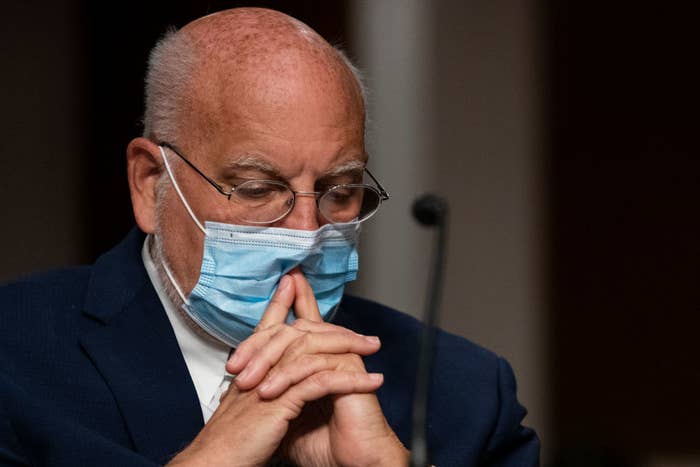The premier health agency's update comes less than two weeks after a similar guidance was added and then deleted from its website.
Posted on October 5, 2020,

Pool / Getty Images
CDC director Robert Redfield at a hearing of the Senate Health, Education, Labor, and Pensions Committee on September 23.
Officials at the CDC said Monday that the coronavirus can spread via particles in the air, a long-delayed acknowledgment of what is increasingly seen as a key form of virus transmission.
On Monday, a new section added to a CDC webpage called "How COVID-19 Spreads" stated that "COVID-19 can sometimes be spread by airborne transmission."
The update stated that infections can occur as a result of viruses present in small droplets suspended in the air for minutes to hours. "These viruses may be able to infect people who are further than 6 feet away from the person who is infected or after that person has left the space," the agency's guidance says.
The addition comes less than two weeks after a similar guidance was posted and then abruptly removed from the website, raising concerns of possible political interference. In response to the incident, the CDC's webpage was updated to say that "a draft version of proposed changes to these recommendations was posted in error."
The new guidance comes months after scientists began pushing the world's top health officials to acknowledge the growing consensus that the virus could be spread via small particles in the air. In July, the World Health Organization issued a scientific finding that indicated that airborne transmission was possible, suggesting the virus could spread in large crowds and indoors in poorly ventilated buildings.
The CDC's new guideline follows similar lines, citing documented instances of transmission in "poorly ventilated and enclosed spaces that often involved activities that caused heavier breathing, like singing or exercise."
Scientists welcomed Monday's long-awaited update from the CDC. Jose-Luis Jimenez, a chemistry professor at the University of Colorado at Boulder, told BuzzFeed News that it was "a move in the right direction."
The bottom line is that "we can get infected if we breathe someone else’s exhaled air," he said. "We have to think that everyone we cross that’s not in our bubble, they're exhaling smoke, like a smoker. How we reduce contagion is breathing as little of that 'smoke' as possible."
Jimenez added that he found some of the language confusing: The CDC makes reference to "small droplets" and "particles," whereas he said that the more precise scientific term would be "aerosols." He also thought that the agency's description of airborne transmission "sometimes" happening likely understated its frequency.
The CDC's change comes as a large cluster of COVID-19 cases spreads in the White House, tied to large, unmasked outdoor gatherings and indoor events.
Scientists have also expressed concerns that such guidance did not come earlier due to political interference. In May, the Washington Post reported that the White House forced the CDC to remove guidelines suggesting that the virus could spread via choirs and music ensembles in religious gatherings. The White House has also interfered with other CDC guidance, most notably on the ability of the virus to spread from children.
The new CDC guidance indicates that close contact with a person who has been infected is still believed to be the primary route of infection.
The CDC Removed A New Guidance About Airborne Coronavirus Transmission Days After Posting It
Dan Vergano · Sept. 21, 2020
Salvador Hernandez · July 10, 2020
Peter Aldhous · Sept. 26, 2020

Azeen Ghorayshi is a science editor for BuzzFeed News and is based in New York.

Stephanie M. Lee is a science reporter for BuzzFeed News and is based in San Francisco.

Azeen Ghorayshi is a science editor for BuzzFeed News and is based in New York.

Stephanie M. Lee is a science reporter for BuzzFeed News and is based in San Francisco.
No comments:
Post a Comment